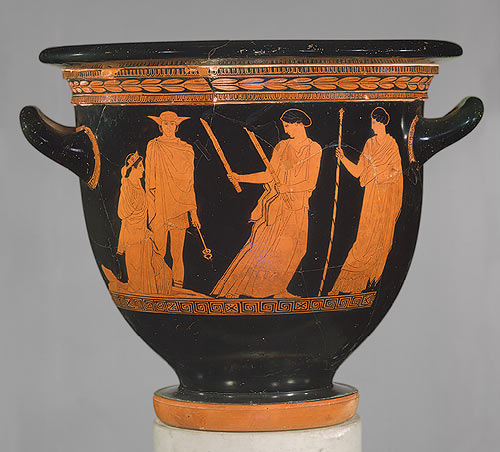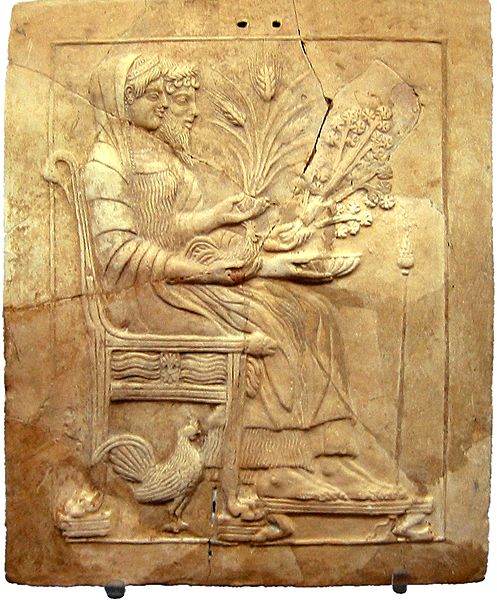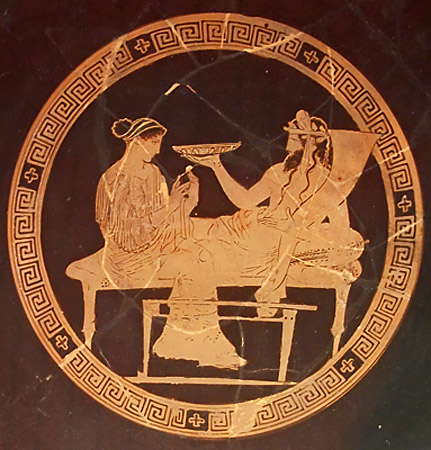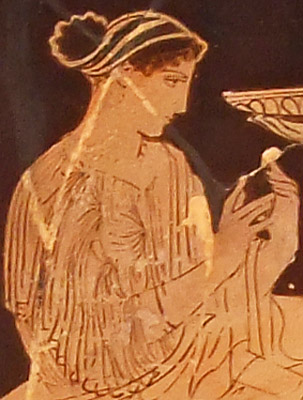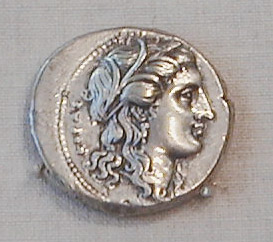The Order of the White Moon Goddess Gallery Presents
Kore and the Eleusinian Mysteries
A Level II final Project for Sisters of the Rising Moon School
By
Literata
Adept and Member of the Order of the White Moon(© 2011. All original material in this site is under copyright protection and is the intellectual property of the author.)
The rituals of the Eleusinian Mysteries centered on the worship of Demeter and her daughter Persephone. In the context of the Mysteries, Persephone was known by the title Kore, which means simply “Maiden.” Although the exact details of how Kore was worshipped in the Eleusinian Mysteries have been lost, you can use the Tarot spread in this project as inspiration for your own encounter with the goddess.
The Eleusinian Mysteries were a series of rituals that culminated in mystical initiation; they were held in and near the Greek city of Eleusis, a day's walk from Athens, from approximately 1500 BCE to 392 CE. Even though the Mysteries endured for almost two millennia and attracted initiates from across the Hellenistic world, we know surprisingly few details, because initiates took a sacred vow of secrecy. We do know that they focused on the worship of Demeter and Kore. Reconstructing the Mysteries is a tricky process of interpolating the gaps in archaeological evidence with what we know about the myths of Demeter and Persephone/Kore. Since the myths themselves are many-layered and often conflicting, mythologists can end up going in circles.
Persephone ascending from the Underworld. Hermes, wearing a headdress, stands beside the spot where she emerges, while Hekate carries two torches to escort her to Demeter, waiting on the far right.
(Courtesy of the Metropolitan Museum of Art web site)One theory, advanced by authors following the lead of C. G. Jung and Karl Kerenyi, holds that the Mysteries included a ritual drama. Initiates may have witnessed or even participated in a reenactment of Demeter's search for Persephone after her abduction by Hades. The drama may have been drawn from the story as told in the Homeric Hymn to Demeter or the Orphic hymns, although there are multiple theories on exactly which parts of the many interlocking stories were told and how the drama had such a significant effect on the initiates. [1]
A second major theory emerged from scientific investigation into entheogens and their historical use. A ritual drink, the kykeon, was consumed during the Mysteries; ethnomycologists speculate that the kykeon may have contained a hallucinogen. The kykeon was made from barley, and barley can harbor the ergot fungus, which has been shown to produce chemicals related to LSD. [2] This theory is improbable, given the difficulties of creating a safe and reliable hallucinogen with the technology of the day, especially since ergot is often poisonous. Extraordinary experiences were part of mystery cults, but any trance or ecstatic states were likely achieved through more reliable spiritual technologies such as fasting, dancing, and disorientation from sensory overload by sudden light and loud sounds. [3]
The most intriguing speculations have to do with the results of the ritual: many authors throughout the time of the Mysteries attested that initiates were unafraid of death. They reported that initiates were assured of having a special place in the afterlife which was much more pleasant and joyful than the rather dull and dreary existence led by the shades of the uninitiated. Since Persephone ruled as Queen of the Underworld, it made sense that she could provide special privileges for those who were devoted to her in life. [4]
Persephone and Hades enthroned together, holding wheat and other crops
(Creative commons license)We do know that large fire was lit in the main building on the night of the initiation. [5] One possibility is that in the climactic ritual, this fire may have been used in a symbolic way to make the initiates immortal, as the Homeric Hymn tells us Demeter tried to do with the infant Demophoon (whom she cared for while Persephone was missing.) [6] Another possibility is that the rites were connected with an assurance of rebirth, since Persephone is also described in the Orphic hymns as "parent of the vine," that is, of Dionysos (also called Zagreus and Euboleus), who died and was reborn multiple times in myth. [7]
The worship of Demeter and Kore was not just about the afterlife, though; another symbolic interpretation of the myths is that Kore is a personification of grain crops, literally the bread of life. One of the few statements we have about what went on at the Eleusinian Mysteries is that a single stalk of grain was exhibited, and even if that account is not reliable, Demeter and Persephone are both often shown with grain as their symbol or as as their gift to humankind. [8] Similarly, Hades, the god of the underworld was alternately known as Ploutos, the wealth-giver, who carries the cornucopia as a symbol of his relationship to abundance not just in terms of minerals below ground but also fertility above it. [9]
Hades holding a cornucopia, with Persephone sitting facing him
(Credit: Ann Raia, 2008)
Close Up of Persephone
(Permission for two images above at http://www.vroma.org/images/image_search.html)
In the older Greek tellings of this myth, Persephone actually spent the summer in the Underworld, not the winter. In the Greek climate, grain was planted in the fall, grew over the winter, was reaped in the spring, and was stored for summer, often underground. Winter, not summer, was a time of growth and fertility. The heat of summer was seen as less lively and more dangerous, and summer was the military campaigning season. In contrast, winters were mild and rainy, and the time when growth was most abundant. Kore is now thought of as a spring goddess, because retellings of the myth were adapted to fit other climates. However, the Eleusinian Mysteries echo the original Greek ecological rhythms. The Mysteries were celebrated at the end of September or beginning of October, corresponding with the fall planting. [10]
This sculpture originally had a golden ear of wheat being given to the child by Demeter,
while Persephone placed a wreath or garland on his head.
(Wikimedia commons license)One of the best introductions to the Eleusinian Mysteries is the first chapter of Hugh Bowden's Mystery Cults of the Ancient World, where he describes the Eleusinian Mysteries as the most famous and best-known of all mystery cults. Bowden accepts that we cannot know precisely what occurred, but gives many details about the rituals that can be known, especially from relatively recently unearthed archaeological evidence. The festival was preceded by priests and priestesses of Eleusis going to Athens, taking with them sacred objects, hiera, in baskets. These objects were not shown to the uninitiated, and although we can speculate that they may have been statues or symbols such as a stalk of grain, we do not know for sure.
The festival started in Athens itself, where initiates had to go to the shore to wash themselves and a piglet in the ocean and then sacrifice the piglet. A few days later they walked in a processional to Eleusis, carrying the sacred objects back with them, and entered the sanctuary, where they rested and drank the kykeon. The secret initiation ritual took place at night, and the euphemistic descriptions of it usually separate it into three parts: things said, things shown, and things done. Of these, the things shown were the most important part. This was when the sacred hiera were exhibited, and the primary priest who showed them to the initiates derived his title from the role: he was the hierophant, he who makes the hiera appear.
This sacred vision, made possible by the large fire, is emphasized as the central part of the initiation by descriptions of initiates as those who had seen the Mysteries. This worship of Kore revolved around an encounter with her, coming face-to-face with the goddess through ritual, rather than on beliefs or explanations. Bowden suggests that initiates developed their own understandings of what they had seen and experienced, which helps explain the overlapping and even conflicting profusion of myths. This process of meaning-making is similar to the way we interpret a Tarot reading by reflecting on it to construct a coherent meaning in a particular context, adapting our understanding and the cards' images to fit together smoothly.
A coin showing Persephone wearing a wreath of grain. Credits: Ann Raia, 2001
(Permission information for above image at http://www.vroma.org/images/image_search.html)
Tarot Spread to Connect with Kore
An Original Tarot Spread by Literata
This Tarot spread takes the form of a stalk of grain and can be an image for you to contemplate as you strive to connect with Kore. It could be done at the beginning of your relationship to her, to gain insight into ways you might try to get to know her better, or to gain insight into a past experience where you felt her presence in your life. Each position is named after something related to the Eleusinian Mysteries, indicating roles the cards can play in your experience. This spread is not as much about divination or understanding the future as it is a way to begin to have an encounter with the goddess. If you want to invoke her promise of guidance in the afterlife and potential for rebirth, light a candle, or better yet, do this reading by firelight.
Positions in the Kore spread:
9
6 8
7
3 5
4
2
11 - Offering: This card may symbolize what you need to give up or leave behind you as you begin your metaphorical journey. It may also be the thing you will do (rather than something to stop doing) to make an offering to the goddess.
2 - Procession: This card represents something that separates your everyday life from your experiences of encountering the goddess (future or past). It symbolizes both the way initiates plunged into the ocean and the long journey on foot to Eleusis afterwards.
3 - Torch: Something or someone who lights your way as you travel appears in this image. This may be closely related to Hecate, who helped bring Persephone back from the Underworld.
4 - Kykeon: Like the ritual drink of barley-water, this card is something that you take into yourself which is unique to your encounter with Kore, possibly something that takes the place of what you gave in offering.
5 - Basket: Representing the baskets in which secret sacred objects were carried in procession, this card holds an image of something that may have a meaning unique to you. What do you take with you to encounter the goddess?
6 - Things said: Interpret this card in the context of a communication that reflects a part of the mysteries of the goddess.
7 - Things seen: This is an experience that was part of the mysteries. Ask yourself how others have played the role of the goddess to you.
8 - Things done: Let this card inspire you to find ways that you may play the role of the goddess towards others.
9 - Stalk of grain: The way you find the encounter appearing in your everyday life afterward may be deceptively simple, but full of meaning. What will you take away from your encounter? What seeds will you plant? And what will your blessings or wealth be?
The "stalk of grain" shape will not be very obvious with round Motherpeace cards. If you do this reading with the usual rectangular cards, tilt the ones on either side (3, 6, 5, and 8) a little away from the central line to make the resemblance more apparent.
Note that if the Hierophant card appears in this reading, it should be interpreted in a positive light with reference to the original hierophant's role as a priest of Kore's mysteries, and not with negative associations with hierarchy, rigidly formalized religion, or the Christian associations of the Pope.
Citations
[1] C. G. Jung and C. Kerenyi, Essays on a Science of Mythology: The Myth of the Divine Child and the Mysteries of Eleusis, trans. R. F. C. Hull. Princeton University Press, 1969, and Karl Kerényi, Eleusis: Archetypal Image of Mother and Daughter, trans. Ralph Manheim, Princeton University Press, 1991. (Transliteration of Kerenyi's first name varied between Carl and Karl.)
[2] R. Gordon Wasson, Albert Hoffman, and Carl A. P. Ruck, The Road to Eleusis: Unveiling the Secret of the Mysteries, Harcourt Brace Jovanovich, 1978. First chapter available online at http://www.psychedelic-library.org/eleucont.htm
[3] Hugh Bowden, Mystery Cults of the Ancient World, Princeton University Press, 2010, p 43.
[4] Bowden, p 26, 48.
[5] Kerenyi, p 92.
[6] Marvin W. Meyer, ed., The Ancient Mysteries, a Sourcebook: Sacred Texts of the Mystery Religions of the Ancient Mediterranean World, University of Pennsylvania Press, 1999, p 26.
[7] Meyer, p 104-5. Although the phrase is rendered there as "maiden rich in fruits," the text still makes it clear that Dionysos is Persephone's son. A different translation of the Orphic hymns including the phrase "parent of the vine" is available online at http://www.theoi.com/Text/OrphicHymns1.html#28
[8] Meyer, p 19. This account is from Hippolytus, a Christian who was writing about the mysteries in a negative light without himself being an initiate, so it must be treated with care, but the repeated grain symbology elsewhere makes it one of the more likely possibilities.
[9] Wikipedia describes Plouton and Ploutos as being conflated although originally separate; in another instance of overlapping myths, one of them he may have been Demeter's son who was merged into the figure of the other, her son-in-law. http://en.wikipedia.org/wiki/Plutus The Orphic hymns refer to him as Plouton and wealth-giver simultaneously.
[10] Bowden, p 31.
For more information about Persephone/Kore online, including snippets of classical references and relationships to other mythological figures, see: http://www.theoi.com/Khthonios/Persephone.html
Return to Goddess Gallery
